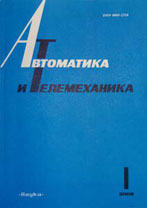|
This article is cited in 4 scientific papers (total in 4 papers)
Optimization, System Analysis, and Operations Research
Principle of constructing procedures for planning behavior of autonomous intelligent robots based on polyvariable conditionally dependent predicates
V. B. Melekhina, M. V. Khachumovbcd
a Dagestan State Technical University, Makhachkala, Dagestan, 367015 Russia
b RUDN University, Moscow, 117198 Russia
c Federal Research Center “Computer Science and Control,” Russian Academy
of Sciences, Moscow, 119333 Russia
d Ailamazyan Progam Systems Institute, Ves’kovo, Yaroslavl oblast, 152021 Russia
Abstract:
We propose a principle of constructing procedures for planning the goal-directed behavior of autonomous intelligent mobile robots of various purposes under underdetermined unstable operating conditions. To build a knowledge representation model, its typical constructions have been developed in the form of implicative decision rules formed on the basis of polyvariable conditionally dependent predicates of various content. The structure of different-in-purpose predicates of this type, which can contain both polyvariables in the form of active fuzzy semantic networks and individual variables of the “object” and “event” types associated with certain conditions of the problem environment, is determined. It is shown that the use of active fuzzy semantic networks permits one to describe various situations and subsituations of the problem environment regardless of a specific subject area, as well as to determine in general terms the relationships that can be observed by an intelligent robot in the process of planning behavior between its objects in the problem environment and the events occurring in it. Knowledge processing tools have been developed at various stages of decision inference that allow constructing effective behavior planning procedures providing autonomous intelligent mobile robots with the ability to perform complex tasks formulated as a generalized description of the target situation of the problem environment. Upper bound estimates are found for the complexity of planning procedures for purposeful behavior by an autonomous intelligent mobile robot built according to the proposed principle of organizing tools for knowledge processing and decision inference.
Keywords:
autonomous intelligent robot, problem environment, knowledge representation model, behavior planning, polyvariable conditionally dependent predicate, implicative decision rules.
Received: 03.10.2021
Revised: 15.12.2021
Accepted: 30.12.2021
Citation:
V. B. Melekhin, M. V. Khachumov, “Principle of constructing procedures for planning behavior of autonomous intelligent robots based on polyvariable conditionally dependent predicates”, Avtomat. i Telemekh., 2022, no. 4, 140–154; Autom. Remote Control, 83:4 (2022), 613–625
Linking options:
https://www.mathnet.ru/eng/at15681 https://www.mathnet.ru/eng/at/y2022/i4/p140
|

| Statistics & downloads: |
| Abstract page: | 89 | | Full-text PDF : | 1 | | References: | 23 | | First page: | 12 |
|



 Contact us:
Contact us: Terms of Use
Terms of Use
 Registration to the website
Registration to the website Logotypes
Logotypes